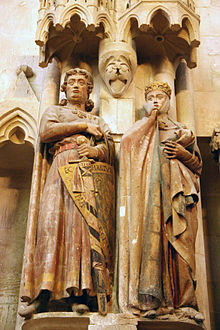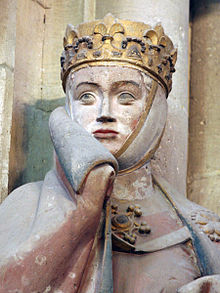Naumburg Cathedral
This article needs additional citations for verification. (January 2016) |
| Naumburg Cathedral | |
|---|---|
Naumburger Dom St. Peter und St. Paul | |
 Naumburg Cathedral of St. Peter and St. Paul | |
| Denomination | Protestant |
| Website | naumburger-dom.de |
| Architecture | |
| Style | Romanesque/Gothic |
| Groundbreaking | 1028 |
| Completed | 1044 (consecration) |
| Administration | |
| Province | Evangelical Church in Central Germany |
| Diocese | Bishopric of Naumburg-Zeitz (until 1615) |
| Clergy | |
| Bishop(s) | Ilse Junkermann |
Naumburg Cathedral (German: Naumburger Dom St. Peter und St. Paul), located in Naumburg, Germany, is the former cathedral of the Bishopric of Naumburg-Zeitz. The church building, most of which dates back to the 13th century, is a renowned landmark of the German late Romanesque. The west choir with the famous donor portrait statues of the twelve cathedral founders (Stifterfiguren) and the Lettner, works of the Naumburg Master, is one of the most significant early Gothic monuments.
The church was erected with the relocation of the Episcopal See from Zeitz in 1028, next to an old Parish church. Thus it is the proto-cathedral of the former Catholic Diocese of Naumburg-Zeitz.
With the Reformation, Naumburg and its cathedral became Protestant. Naumburg Cathedral remains a Protestant parish church to this day.
Naumburg Cathedral is a part of the tourist route Romanesque Road in Saxony-Anhalt. Since 1999, 'The Naumburg Cathedral and the landscape of the rivers Saale and Unstrut – an important dominion in the High Middle Ages' are included in the candidate list for UNESCO World Heritage Sites in Germany.
History

Naumburg Castle
Around 1000 AD, Markgraf (Margrave) Ekkehard I of Meissen and the most powerful man on the eastern border of the Holy Roman Empire erected a residence on a roughly 25 metres (82 ft) high rock above the right bank of the Saale river, near the mouth of the Unstrut. The location for this castle, which was called neweburg that later became "Naumburg," was chosen for its advantageous proximity to the intersection of so many well-trafficked commercial highways on the historic eastern border of East Francia (Kingdom of Germany) with the lands of the Polabian Slavs that were incorporated into the Saxon Eastern March.
Ekkehard's sons, the Meissen margraves Hermann and Eckehard II, founded a small parish church in the western part of the area around the castle. It was dedicated to the Virgin Mary and was first mentioned in surviving texts of the Merseburg bishopric chronicle in 1021. In 1028, after some encouragement from the brothers they won approval from King Conrad II and Pope John XIX to move the episcopal see from Zeitz to Naumburg on the grounds that the castle would provide more protection for the see than it could get in Zeitz.
Early-Romanesque Stage
Soon after the approval of the relocation of the Episcopal See, in the Spring of 1029, just to the east of the existing parish church the construction of the early-Romanesque Cathedral was begun. In 1044, during the reign of Bishop Hunold of Merseburg, the church was consecrated and the patron saints of Peter and Paul were designated, adopted from Zeitz Cathedral.
Reformation
In the course of the Reformation, it became the see of the first German Protestant bishop, Nicolaus von Amsdorf in 1542. Upon the death of his Catholic "antibishop", Julius von Pflug in 1564, the Catholic Naumburg diocese was administrated by the Electors of Saxony and finally dissolved in 1615.
Description
Interior works of art



The Stifterfiguren (donor figures) by the artist called Naumburger Meister (Master of Naumburg) are probably the best-known work of art in the cathedral and are often referred to as the best-known work of early Gothic sculpture in Germany. Situated in the western choir, the twelve life-sized sculptures (eight men and four women) show nobles who were among the founders of the cathedral.[1]
The sculptures are thought to represent the following people (from northeast to southeast):
- Graf Konrad
- Gräfin Gepa (or Adelheid von Gernrode)
- Gräfin Uta von Ballenstedt and Markgraf Ekkehard II of Meissen (as a couple)
- Graf Thimo von Kystritz ((Timo de Kistricz, Comes de Wettin, Comes de Brena, Graf zu Seußlitz und Kistritz, Herzog zu Meißen)
- Graf Wilhelm von Camburg und Brehna
- Graf Sizzo von Kevernburg
- Graf Dietmar
- Gräfin Reglindis and Markgraf Hermann I of Meissen, brother of Ekkehard (as a couple)
- Graf Dietrich von Brehna and Gerburg, his wife
The sculptures were created in the middle of the 13th century out of Grillenburg Sandstone. Ten of the figures are merged with the walls, two are free-standing. They were originally painted but those remains of paint visible today date from restoration work in the 16th to 19th centuries.[1]
For early Gothic sculptures, these figures are extremely realistic and show a large amount of individual detail. The character of the sculptures and the very presence of figures of lay people in such a prominent place in the church make these unique in 13th-century European sculpture.[1]
Also by the same artist, the Westlettner (western rood screen) features sculpture from the Passion of Christ.[2]
The Elisabethkapelle, a chapel dedicated to St. Elisabeth contains the oldest known stone sculpture of the saint. It was likely created shortly after Elisabeth's canonization in 1235, only four years after her death. The statue's head used to hold relics of the saint.[3]
The cathedral's windows feature work by Neo Rauch in the Elisabethkapelle and by de in the crypt and the baptistery.
References
- ^ a b c "Bekannteste Skulturen der deutschen Frühgotik (German)". Vereinigte Domstifter zu Merseburg und Naumburg. Retrieved 15 April 2016.
- ^ "Naumburger Meister (German)". Vereinigte Domstifter zu Merseburg und Naumburg. Retrieved 15 April 2016.
- ^ "Älteste bildliche Darstellung der hl. Elisabeth (German)". Vereinigte Domstifter zu Merseburg und Naumburg. Retrieved 15 April 2016.
Further reading
- Gerhard Straehle: Der Naumburger Meister in der deutschen Kunstgeschichte. Einhundert Jahre deutsche Kunstgeschichtsschreibung 1886-1989. Dissertation at Ludwig-Maximilians-Universität München 2009. (full text)
- Gerhard Straehle: Der Naumburger Stifter-Zyklus und der Erschlagene im Westchor (Synodalchor) des Naumburger Doms. Verlag Langewiesche, Königstein 2012, ISBN 978-3-7845-2960-8.

